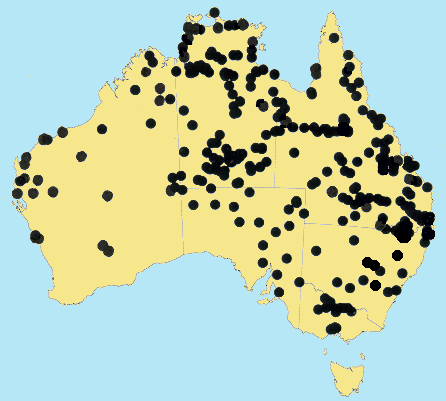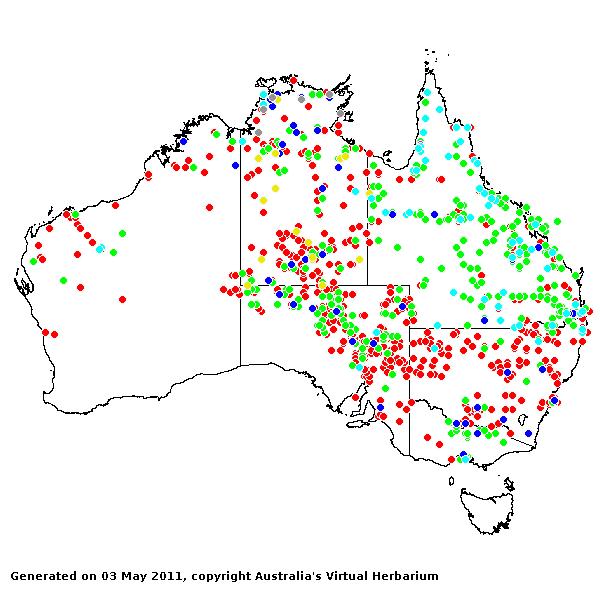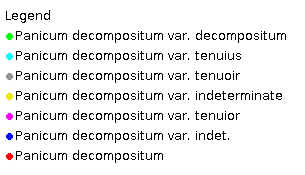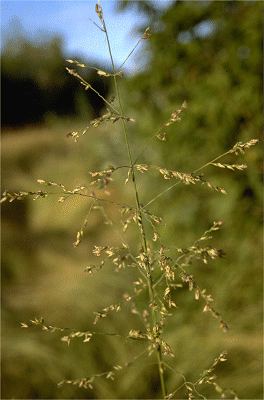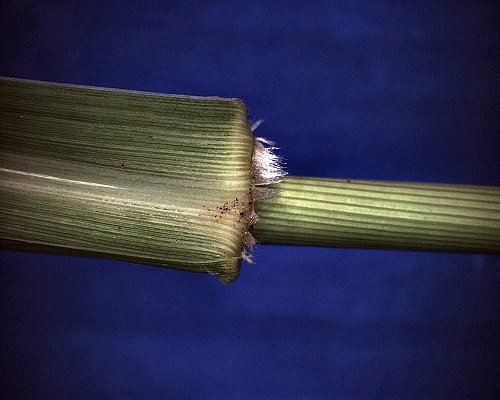Panicum decompositum R. Br. Prodr.
191 (1810).
Classification. (GPWG 2001) : Subfamily
Panicoideae. Paniceae.
Type of Basionym or
Protologue Information: "(T.) Littora Novae Hollandiae intra tropicum.",.
Key references
(books and floras): [1810]. R.Brown, Prodromus (191), [1878]
G.Bentham, Flora Australiensis 7 (489), [1952] C.A.Gardner, Flora of
Western Australia 1 Gramineae (259), [1981] M.Lazarides in J.Jessop
(ed)., Flora of Central Australia (471), [2002] D.Sharp & B.K.Simon,
AusGrass, Grasses of Australia, [2006] J.Jessop, G.R.M.Dashorst,
F.M.James, Grasses of South Australia (459), [2008] S.W.L.Jacobs,
R.D.B.Walley & D.J.B.Wheeler, Grasses of New South Wales.
Illustrations:
[2006] J.Jessop, G.R.M.Dashorst, F.M.James, Grasses of South Australia (460, fig. 392 as var. decompositum),
[2008] S.W.L.Jacobs, R.D.B.Whalley & D.J.B.Wheeler, Grasses of New South
Wales, 4th edn (315).
Habit. Perennial. Rhizomes absent. Stolons absent. Culms erect, 30–80 cm
tall, compressible, 2–6 -noded. Mid-culm internodes glabrous. Mid-culm nodes
glabrous or pubescent. Lateral branches simple or sparsely branched.
Leaf-sheaths glabrous on surface or hairy. Leaf-sheath auricles absent. Ligule
a fringed membrane, a ciliolate membrane, 2 mm long. Leaf-blades linear, flat
or conduplicate or involute, 7–50 cm long, 2.5–12 mm wide. Leaf-blade surface
smooth, glabrous or indumented.
Inflorescence.
Inflorescence compound, a panicle. Panicle ovate, 15–35 cm long, evenly
furnished or with spikelets clustered towards branch tips.
Spikelets.
Spikelets pedicelled. Fertile spikelets 2-flowered, the lower floret barren
(rarely male), the upper fertile, comprising 1 basal sterile florets,
comprising 1 fertile floret(s), without rachilla extension, lanceolate or
elliptic or ovate, dorsally compressed, 2.3–3.5 mm long. Rhachilla internodes
elongated between glumes.
Glumes. Glumes
thinner than fertile lemma. Lower glume ovate or obovate, membranous, without
keels, 0–1 -nerved. Lower glume apex muticous. Upper glume lanceolate or
elliptic, 2.1–2.9 mm long, membranous, without keels, 7–9 -nerved. Florets.
Basal sterile florets 1, barren, with palea. Lemma of lower sterile floret 100
% of length of spikelet, membranous, 7 -nerved, muticous.
Fertile lemma 1.8–2.2
mm long, without keel, 7 -nerved. Lemma apex muticous. Anthers 3. Grain 1.5 mm
long.
Continental
Distribution: Australasia and Pacific.
Australian
Distribution: Western Australia, Northern Territory, South Australia,
Queensland, New South Wales, Victoria.
Western Australia:
Gardner, Fitzgerald, Dampier. Canning, Giles, Fortescue, Ashburton, Carnarvon,
Austin. Coolgardie. Northern Territory: Darwin & Gulf, Victoria
River, Barkly Tableland, Central Australia North, Central Australia South. South
Australia: North-western, Lake Eyre, Gairdner-Torrens Basin, Flinders
Ranges, Eastern, Eyre Peninsula, Northern Lofty, Murray, Southern Lofty. Queensland:
Burke, Burnett, Cook, Darling Downs, Gregory North, Leichhardt, Maranoa,
Mitchell, Moreton, North Kennedy, Port Curtis, South Kennedy, Warrego, Wide
Bay, Gregory South. New South Wales: North Coast, Central Coast,
North-Western Slopes, Central-Western Slopes, South-Western Slopes,
North-Western Plains, South-Western Plains, North Far Western Plains, South Far
Western Plains. Victoria: Midlands, Riverina, Volcanic Plain.
Notes.
Morphologically variable with intergrading forms. Specimens from the tropics of
northern Australia have larger spikelets, rigid and filiform leaf blades, and
hairy axils and represent a distinct new species.
In dry sclerophyll
forests, Brigalow forests, tropical and subtropical sub-humid woodlands,
temperate sub-humid woodlands, shrub steppe shrublands, acacia shrublands, arid
tussock grasslands, and arid hummock grasslands. Occurs naturally over a wide
area of arid, semiarid and mesic Australia. Flowers throughout the year.
Infra-specific taxa: var. decompositum, var. tenuior .
Spikelets 2.5–2.8 mm
long P. decompositum var. tenuius
Spikelets 3–3.5 mm
long P. decompositum var. decompositum
